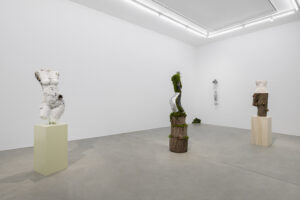Ambra Castagnetti’s (Genoa, 1993) exhibition appears to be the discovery of an archeological after party, after a Witches’ Sabbath, after a great spiritual feast in a forest clearing. What remains composes her first solo exhibition for Francesca Minini Gallery, the Zone, whose title is an explicit reference to Andrej Tarkovskij’s film Stalker (1979). We are greeted by a head, with eyelashes made of feathers, slumbering on moss to act as a pillow, Hypnagoth (2023). Continuing on we notice the presence of hybrid nude bodies in spiritual and material synergy with their surroundings. Confirming this scenario, the work Hungover (2023) is an aluminum sculpture of two longilinear legs with shoes swaddling their feet (reminiscent of Nike Uptempo or Buffalo, among others). Also the canine heads made of aluminum, from the Ponycore series (2023), are resting on the moss. In this wild setting the main subject is the sense of the body represented here in hybrid guises with the animal, plant and human kingdoms.

Ambra Castagnetti, The Zone, installation view at Francesca Minini, Milan, photo Andrea Rossetti, Courtesy Francesca Minini, Milan
Scorpia (2023) is a creature made of aluminum, plastic, resin and studs that dot the tail and sting of the half scorpion; Boschiva (2023), on the other hand, appears as the Daphne of Ovid’s Metamorphoses, made of aluminum, moss, stem, plastic, resin, electrical wires and glass crystals, in transformation and in total fusion with her pedestal made from a tree trunk. References to classical mythology seem to continue with Tank Girl (2023) armed – like Athena – with aluminum on her abdomen and flowers and leaves on her chest. The photographic print Aeterna (2023) is what makes this vision real: a tattooed body in which pubic hair has become moss, a panic fusion with the Earth.

Ambra Castagnetti, The Zone, installation view at Francesca Minini, Milan, photo Andrea Rossetti, Courtesy Francesca Minini, Milan
At the far end of the gallery it is recreated an environment in which the work City of Walls (2023), in total cyber punk aesthetic, coexists with the sound of a small fountain from which water flows. It appears as a kind of spring, a primordial broth, a well surrounded by moss in which the motherboards that make up its interior are endlessly reflected through a play of mirrors. As in the Japanese anime Akira and Evangelion, a philosophical-technological hybridization takes place between the great metropolis and the subject that incorporates the suburban landscape. The Zone is an imaginative process that occurs through deep meditation, leading toward lucid dreaming and telling of an organism that proposes itself as fluid, manifesting the urgency of anti-speciesist and anti-binary hybridization. Taking its cue from the Xenofeminist Manifesto (2015) by the Laboria Cuboniks collective, the body shown here is a statement of semantic reversal and questions us about the meaning of identity and the connection between the external body and the inner landscape.

Ambra Castagnetti, The Zone, installation view at Francesca Minini, Milan, photo Andrea Rossetti, Courtesy Francesca Minini, Milan
As chance would have it, during this same period Milan saw the presence of Paul B. Preciado (Burgos, 1970), who, at the presentation of his book Dysphoria Mundi, highlighted how this is the greatest epistemological revolution since 1492, when values and imaginaries related to sex, the body and gender identity were created as part of social structures that now appear to be completely collapsing. According to Preciado, the revolutionary cell of this change is ourselves, so it is necessary to question the parameters referred to a tradition that is more than 500 years old. Castagnetti’s works act in this sense by representing urgencies of the contemporary generation, heirs of a thought that has its roots in the Post-human, a discourse that has been open for thirty years.
Angelica Lucia Raho
Info:
The Zone, Ambra Castagnetti
Galleria Francesca Minini
via Massimiano 25, Milano
18/05 – 28/07/2023
www.francescaminini.it

Lecce, 1999. After a three-year degree in Communication and Art Teaching and a two-year specialist course in Visual Cultures and curatorial practices at the Brera Academy of Fine Arts, she collaborates with art magazines and with independent curatorial projects between Lecce and Milan.






NO COMMENT